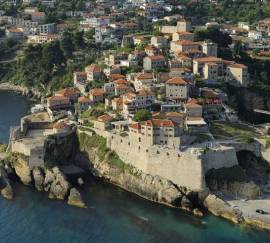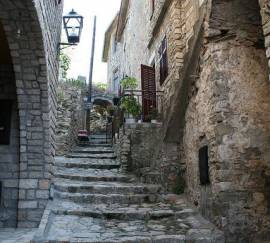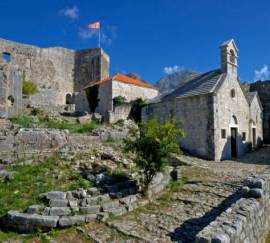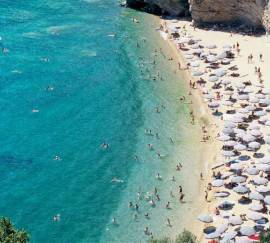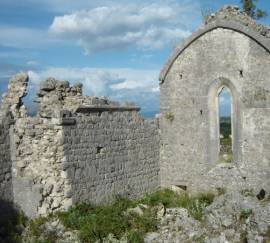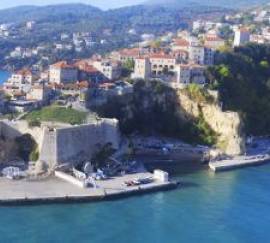BAR
Bar is a Montenegrin town with 13.000 inhabitants located on the Adriatic coast. Because of the one of the biggest harbours in Montenegro (at the same time one of the most important harbours of the former Yugoslavia), ferry connections with harbours in Ancona and Bari on the other side of the Adriatic and the beginning of the railway line connecting Belgrade and Podgorica with coastline it is a very important communication centre. Bar divides in Old and New Bar.
Local archaeological findings date back to the Neolithic. It is assumed that Bar was mentioned as the reconstructed Roman castle Antipargal in the 6th century and the name Antibarium was quoted for the first time in the 10th century.[citation needed]
Slavs overwhelmed the Balkans in the 6th and 7th century. Duklja, a Slavic, or Serbian state, was mentioned in the 10th century. Jovan Vladimir (r. ca. 1000–16), the first known ruler of Duklja whose history is known, had his seat in Skadarska Krajina. Stefan Vojislav (r. 1018–1043), the eponymous founder of the Vojislavljević dynasty, defeated the Byzantines at a hill near the city, and greatly expanded the state to include the other Serbian principalities which were under Byzantine rule. Mihailo I of Duklja (r. 1050–81), Vojislav's son, was also seated here, and upon crowning as king, blessed by the pope, he established the Archdiocese of Antivari. Afterwards, Duklja continued to fight the Byzantines in order to secure independence, and it eventually united into the Serbian Grand Principality, ruled by the Vukanović dynasty (1101–1166), though Bar was mostly under Byzantine rule during this period. In 1183, Stefan Nemanja conquered Bar from the Byzantines, and it stayed in Serbian rule onwards, under the Nemanjić dynasty.
From 1443 to 1571 the region was under the rule of Republic of Venice, and Bar (called Antivari in Venetian, spoken there until the 18th century) was part of the Albania Veneta. During the Middle Ages, Bar was the centre of the South Adriatic coast, a city–state which had a coat of arms, flag, statute and minted its own coins. The Ottomans captured Bar in 1571 and it remained in their hands until 1878. During this period it still had an archbishop. One of the more famous men to hold this office was Andrija Zmajević.
On July 13, 1941, in Bar’s municipality the uprising against the occupying power began and the first shots were fired in districts of Bar and Cetinje.
Ulcinj is the southernmost town in Montenegro. The town of Ulcinj has a population of 10,707 (2011 census) of which the majority are Albanians. Ulcinj is the centre of Ulcinj Municipality and the centre of the Albanian community in Montenegro. The Day of Ulcinj is held every first Saturday of April. It symbolizes the end of the collection of olives, the output of the sailors at the sea, and the beginning of the tourist season.
Ulcinj is a popular tourist destination in summer. In January 2010, the New York Times named ranked the south coast region of Montenegro, featuring Velika Plaza, Ada Bojana, and the Hotel Mediteran, as one of "The Top 31 Places to Go in 2010".
Although still undiscovered by many travelers from larger countries, repeat tourists and an increasing amount of first time visitors make Ulcinj a hot spot for vacationers between the months of May and September. It is most famous for its sandy beaches, which are considered the most beautiful in Montenegro. The most valuable resource of the Ulcinj riviera is Velika Plaza (Albanian: Plazha e Madhe, English: Longe Beach), which is a 12 km (7.5 mi) long stretch of sandy beach and the longest beach on the Montenegrin coast. There is a small pebble beach called Ladies Beach which folk tradition holds to have qualities conducive to fertility. There is also a beach called Mala Plaža which is much smaller in size, but is located in the centre of town and very popular with visitors. "The Korzo", as it is called by locals, is a promenade which separates a street lined with coffee shops from Mala Plaža. At night during the summer months, the Korzo is pedestrianised and families and young people gather. There are many more less known smaller beaches that serve as get-aways from the main tourist areas. Ulcinj has also a large number of religious buildings like mosques, tyrbes and churches, including: Pasha's Mosque, Sailor's Mosque and St. Nicholas Church.
Ulcinj's old town is a very well preserved castle-looking community that is left over from medieval times. The old town sits atop a mountain overlooking the shore and is a tourist attraction on its own.
Ada Bojana (Albanian: Buna) is popular among foreign tourists from Western Europe for its peace and unique atmosphere. A large naturist campsite is located in Ada Bojana.
Šaško lake and Ulcinj's salt pond are popular among birdwatchers, because Ulcinj and its surroundings are major resting points for over 200 bird species on their migration paths.
There are numerous cafes, discos, and bars that dot the city that are usually filled to capacity throughout the summer.
The majority of tourists that came in Ulcinj are Albanians (moslty from Kosovo and Switzerland), Germans, Italians, and Eastern Europeans. A large number of Americans who are either of Albanian descent or were born in or near the city of Ulcinj often make the city a prime summer time destination.


